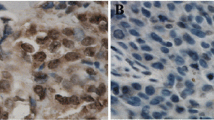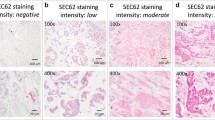Abstract
Small proline rich repeat protein 3 (SPRR3), a member of the SPRR family of cornified envelope precursor proteins, is a marker for terminal squamous cell differentiation. Previously, this laboratory showed that SPRR3 is strongly upregulated in colorectal tumors, and is involved in the tumorigenesis. The current study was performed to investigate the expression status and effect of SPRR3 in breast cancers (BCs). SPRR3 expression was examined by immunohistochemistry in 241 tumor samples from BC patients. SPRR3 was overexpressed in more than half of all BC samples. SPRR3 overexpression was significantly associated with less advanced stage (0–1 vs. II–III) and the absence of lymph node metastasis (P = 0.004 and 0.013, respectively). HER2/neu overexpression was closely correlated with SPRR3 overexpression in a multivariate analysis (OR, 3.23, P = 0.017). To assess the influence of SPRR3 on cell proliferation and related signaling pathways, SPRR3-transfected clones from the SPRR3-negative T-47D human BC cell line were generated. Among the total of six SPRR3-overexpressing clones, five showed marked proliferation compared with SPRR3-nonexpressing control cells from day 3 of culture (P < 0.001). The SPRR3-overexpressing BC clones showed increased phosphorylation of AKT and MDM2, p21 overexpression, and p53 downregulation. Furthermore, phosphorylation of MEK and MAPK was markedly increased. This study demonstrates that SPRR3 promotes BC cell proliferation by enhancing p53 degradation via the AKT and MAPK pathways and is, therefore, a potential novel therapeutic target for less advanced stages of BC.



Similar content being viewed by others
Abbreviations
- AKT:
-
Serine/threonine protein kinase
- BC:
-
Breast cancer HR
- CI:
-
Confidence interval
- CRC:
-
Colorectal cancer
- DFS:
-
Disease-free survival
- ER:
-
Estrogen receptor
- ESCC:
-
Esophageal squamous cell cancer
- HER2/neu:
-
Human epidermal growth factor receptor 2
- HR:
-
Hazard ratio
- MAPK:
-
Mitogen-activated protein kinase
- MDM2:
-
Murine double minute 2
- MEK:
-
MAPK/extracellular signal-regulated kinase
- OR:
-
Odds ratio
- OS:
-
Overall survival
- PI3K:
-
Phosphatidylinositol 3′ kinase
- PR:
-
Progesterone receptor
- RAF:
-
Rapidly accelerated fibrosarcoma
- REMARK:
-
Reporting recommendations for tumor marker prognostic studies
- siRNA:
-
Small interfering ribonucleic acid
- SPRR3:
-
Small proline rich repeat protein 3
- TNBC:
-
Triple negative BC
References
Ko SS, Korean Breast Cancer Society (2005) Chronological changing patterns of clinical characteristics of Korean breast cancer patients during 10 years (1996–2006) using nationwide breast cancer registration on-line program: biannual update. J Surg Oncol 98:318–323
Parkin DM, Bray FI, Devesa SS (2001) Cancer burden in the year 2000. The global picture. Eur J Cancer 37:S4–S66
Joensuu H, Kellokumpu-Lehtinen PL, Bono P, Alanko T, Kataja V, Asola R, Utriainen T, Kokko R, Hemminki A, Tarkkanen M, Turpeenniemi-Hujanen T, Jyrkkiö S, Flander M, Helle L, Ingalsuo S, Johansson K, Jääskeläinen AS, Pajunen M, Rauhala M, Kaleva-Kerola J, Salminen T, Leinonen M, Elomaa I, Isola J, Investigators FinHer Study (2006) Adjuvant docetaxel or vinorelbine with or without trastuzumab for breast cancer. N Engl J Med 354:809–820
Piccart-Gebhart MJ, Procter M, Leyland-Jones B, Goldhirsch A, Untch M, Smith I, Gianni L, Baselga J, Bell R, Jackisch C, Cameron D, Dowsett M, Barrios CH, Steger G, Huang CS, Andersson M, Inbar M, Lichinitser M, Láng I, Nitz U, Iwata H, Thomssen C, Lohrisch C, Suter TM, Rüschoff J, Suto T, Greatorex V, Ward C, Straehle C, McFadden E, Dolci MS, Gelber RD, Adjuvant Herceptin, (HERA) Trial Study Team (2005) Trastuzumab after adjuvant chemotherapy in HER2-positive breast cancer. N Engl J Med 353:1659–1672
Kaufman PA, Swain SM, Pisansky TM, Fehrenbacher L, Kutteh LA, Vogel VG, Visscher DW, Yothers G, Jenkins RB, Brown AM, Dakhil SR, Mamounas EP, Lingle WL, Klein PM, Ingle JN, Wolmark N (2005) Trastuzumab plus adjuvant chemotherapy for operable HER2-positive breast cancer. N Engl J Med 353:1673–1684
Gutierrez C, Schiff R (2011) HER2: biology, detection, and clinical implications. Arch Pathol Lab Med 135:55–62
Ross JS, Slodkowska EA, Symmans WF, Pusztai L, Ravdin PM, Hortobagyi GN (2009) The HER-2 receptor and breast cancer: ten years of targeted anti-HER-2 therapy and personalized medicine. Oncologist 14:320–368
López-Knowles E, O’Toole SA, McNeil CM, Millar EK, Qiu MR, Crea P, Daly RJ, Musgrove EA, Sutherland RL (2010) PI3K pathway activation in breast cancer is associated with the basal-like phenotype and cancer-specific mortality. Int J Cancer 126:1121–1131
Castaneda CA, Cortes-Funes H, Gomez HL, Ciruelos EM (2010) The phosphatidyl inositol 3-kinase/AKT signaling pathway in breast cancer. Cancer Metastasis Rev 29:751–759
Lacroix M, Toillon RA, Leclercq G (2006) p53 and breast cancer, an update. Endocr Relat Cancer 13:293–325
Tesfaigzi J, Th’ng J, Hotchkiss JA, Harkema JR, Wright PS (1996) A small proline-rich protein, SPRR1, is upregulated early during tobacco smoke-induced squamous metaplasia in rat nasal epithelia. Am J Respir Cell Mol Biol 14:478–486
De Heller-Milev M, Huber M, Panizzon R, Hohl D (2000) Expression of small proline rich proteins in neoplastic and inflammatory skin diseases. Br J Dermatol 143:733–740
Kim JC, Kim SY, Roh SA, Cho DH, Kim DD, Kim JH, Kim YS (2008) Gene expression profiling: canonical molecular changes and clinicopathological features in sporadic colorectal cancers. World J Gastroenterol 14:6662–6672
Cho DH, Jo YK, Roh SA, Na YS, Kim TW, Jang SJ, Kim YS, Kim JC (2010) Upregulation of SPRR3 promotes colorectal tumorigenesis. Mol Med 16:271–277
McShane LM, Altman DG, Sauerbrei W, Taube SE, Gion M, Clark GM (2005) Reporting recommendations for tumor marker prognostic studies (REMARK). J Natl Cancer Inst 97:1180–1184
Kimchi ET, Posner MC, Park JO, Darga TE, Kocherginsky M, Karrison T, Hart J, Smith KD, Mezhir JJ, Weichselbaum RR, Khodarev NN (2005) Progression of Barrett’s metaplasia to adenocarcinoma is associated with the suppression of the transcriptional programs of epidermal differentiation. Cancer Res 65:3146–3154
Luthra R, Wu TT, Luthra MG, Izzo J, Lopez-Alvarez E, Zhang L, Bailey J, Lee JH, Bresalier R, Rashid A, Swisher SG, Ajani JA (2006) Gene expression profiling of localized esophageal carcinomas: association with pathologic response to preoperative chemoradiation. J Clin Oncol 24:259–267
Kimos MC, Wang S, Borkowski A, Yang GY, Yang CS, Perry K, Olaru A, Deacu E, Sterian A, Cottrell J, Papadimitriou J, Sisodia L, Selaru FM, Mori Y, Xu Y, Yin J, Abraham JM, Meltzer SJ (2004) Esophagin and proliferating cell nuclear antigen (PCNA) are biomarkers of human esophageal neoplastic progression. Int J Cancer 111:415–417
Yarden Y (2001) Biology of HER2 and its importance in breast cancer. Oncology 61(suppl 2):1–13
Pal SK, Childs BH, Pegram M (2011) Triple negative breast cancer: unmet medical needs. Breast Cancer Res Treat 125:627–636
Dent R, Trudeau M, Pritchard KI, Hanna WM, Kahn HK, Sawka CA, Lickley LA, Rawlinson E, Sun P, Narod SA (2007) Triple-negative breast cancer: clinical features and patterns of recurrence. Clin Cancer Res 13:4429–4434
Cross DA, Alessi DR, Cohen P, Andjelkovich M, Hemmings BA (1995) Inhibition of glycogen synthase kinase-3 by insulin mediated by protein kinase B. Nature 378:785–789
Zhou BP, Liao Y, Xia W, Spohn B, Lee MH, Hung MC (2001) Cytoplasmic localization of p21Cip1/WAF1 by Akt-induced phosphorylation in HER-2/neu-overexpressing cells. Nat Cell Biol 3:245–252
Zhou BP, Liao Y, Xia W, Zou Y, Spohn B, Hung MC (2001) HER-2/neu induces p53 ubiquitination via Akt-mediated MDM2 phosphorylation. Nat Cell Biol 3:973–982
Ogawara Y, Kishishita S, Obata T, Isazawa Y, Suzuki T, Tanaka K, Masuyama N, Gotoh Y (2002) Akt enhances Mdm2-mediated ubiquitination and degradation of p53. J Biol Chem 277:21843–21850
Agrawal A, Yang J, Murphy RF, Agrawal DK (2006) Regulation of the p14ARF-Mdm2–p53 pathway: an overview in breast cancer. Exp Mol Pathol 81:115–122
Tartaglia M, Gelb BD (2010) Disorders of dysregulated signal traffic through the RAS-MAPK pathway: phenotypic spectrum and molecular mechanisms. Ann NY Acad Sci 1214:99–121
McCubrey JA, Steelman LS, Chappell WH, Abrams SL, Wong EW, Chang F, Lehmann B, Terrian DM, Milella M, Tafuri A, Stivala F, Libra M, Basecke J, Evangelisti C, Martelli AM, Franklin RA (2007) Roles of the Raf/MEK/ERK pathway in cell growth, malignant transformation and drug resistance. Biochim Biophys Acta 1773:1263–1284
Acknowledgments
This study was supported by grants to J.C.K. from the Asan Institute for Life Sciences (2011-069), the Korea Health 21 R&D Project (A062254) and the Center for Development and the Commercialization of Anti-Cancer Therapeutics (A102059), Ministry of Health, Welfare, and Family Affairs, Republic of Korea.
Conflict of interest
The authors declare that they have no competing interests.
Author information
Authors and Affiliations
Corresponding authors
Rights and permissions
About this article
Cite this article
Kim, J.C., Yu, J.H., Cho, Y.K. et al. Expression of SPRR3 is associated with tumor cell proliferation in less advanced stages of breast cancer. Breast Cancer Res Treat 133, 909–916 (2012). https://doi.org/10.1007/s10549-011-1868-5
Received:
Accepted:
Published:
Issue Date:
DOI: https://doi.org/10.1007/s10549-011-1868-5




